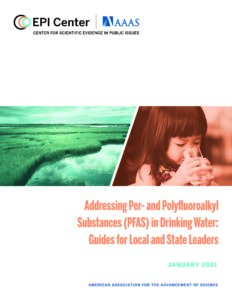New AAAS EPI Center Risk Communication Guide for Local and State Leaders on Addressing PFAS in Drinking Water
 The American Association for the Advancement of Science Center for Scientific Evidence in Public Issues (AAAS EPI Center) has published a new PFAS risk communication guide, that is one of four guides on, “Addressing PFAS in Drinking Water: Guides for Local and State Leaders.” These guides were developed to help local and state leaders understand the current scientific evidence as they evaluate the risk of PFAS contamination of drinking water and include:
The American Association for the Advancement of Science Center for Scientific Evidence in Public Issues (AAAS EPI Center) has published a new PFAS risk communication guide, that is one of four guides on, “Addressing PFAS in Drinking Water: Guides for Local and State Leaders.” These guides were developed to help local and state leaders understand the current scientific evidence as they evaluate the risk of PFAS contamination of drinking water and include:
1. Scientific Overview of PFAS and Drinking Water: This guide includes information about toxicology and health implications, exposure pathways, status of US regulations, and current research.
2. Monitoring and Occurrence of PFAS in Drinking Water: This guide includes information about drinking water contamination, using a “one water” approach, using data to determine community risk, developing monitoring plans and tips for sampling.
3. Treatment and Mitigation of PFAS in Drinking Water: This guide includes information about removing PFAS from drinking water, effective treatment methods and methods in development.
4. PFAS Risk Communications: This most recently published guide includes information about engaging communities, developing a PFAS risk communications plan and key messages, tools and tactics, and performance metrics and reporting.
Each section of the guide is comprised of key takeaways, tables, graphics and resources with helpful information. The newest guide on risk communication includes easy steps and examples of theoretical situations with proposed government official or utility responses that can be customized based on the stakeholders, health impacts, and risk levels for different audiences. The guides can also help people engage their community members, drinking water providers, local and state regulatory agencies, and federal agencies to address PFAS in drinking water. For more information and to download the guides, visit the website and/or view and download the risk communication guide here.

